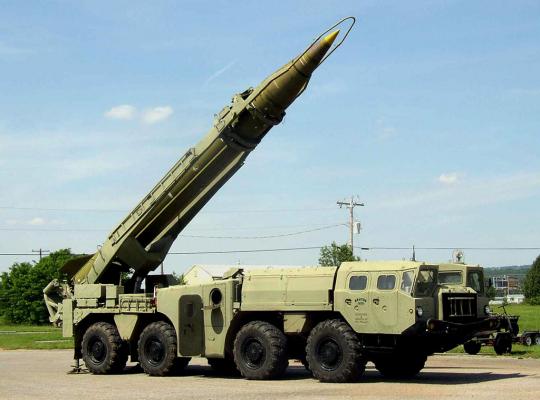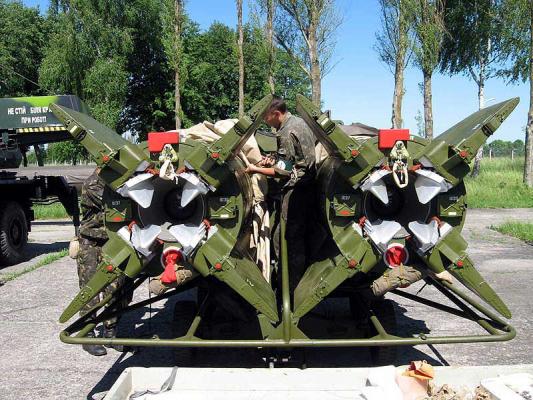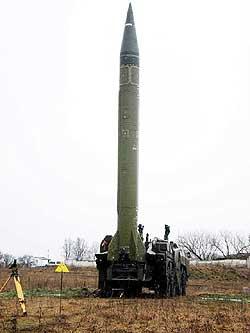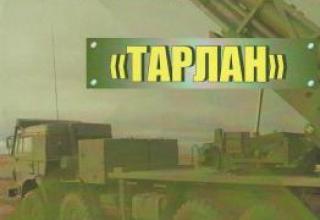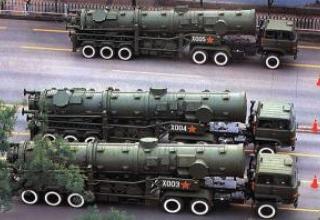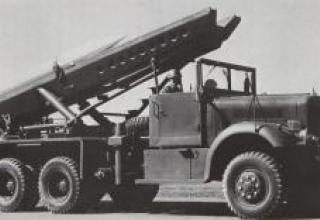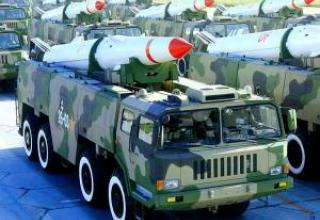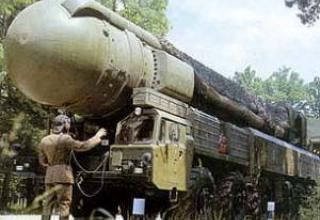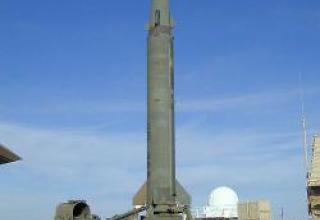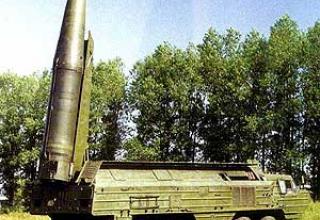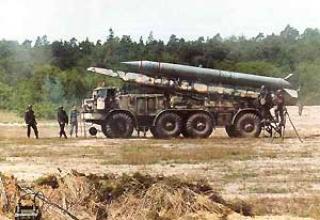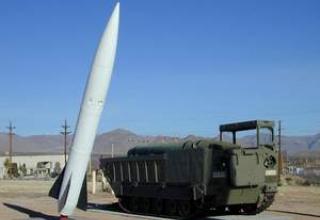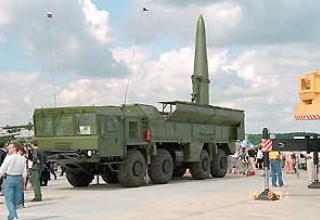Army operational-tactical missile system 9K72 "Elbrus" with a missile 8K-14 (P-17) is designed to destroy manpower, control points, airfields and other critical enemy facilities.
The 9K72 anti-tank missile system was developed in 1958-1961 by SKB-385 (chief designer - V.P. Makeev) with the participation of a number of design bureaux and research institutes. The developers of the main systems of the complex were appointed:
- NII-592 - on board control system (Chief Designer - N.A. Semihatov);
- Design Bureau-3 - on the engine at the first stage of flight tests (Chief Designer - D.D. Sevruk, Chief Designer - N.I. Leontiev);
- Design Bureau-5 - on the engine from the second stage of flight tests (Chief Designer - A.M.Isayev, Chief Designer - N.V.Malysheva);
- Research Institute-944 - on Gyroscopic Instruments (Chief Designer - V.I. Kuznetsov);
- NII-6 - on explosive charge and conventional head-end equipment;
- Research Institute-1011 IMS - on the special charge and a set of electro-automatics (Scientific Director - Yu.B. Hariton, Chief Designer - S.G. Kocharyants) ;
- SSCB - for the complex of ground equipment (Chief Designer - V.P. Petrov, Leading Designer - S.S. Vanin);
- Plant 784 of Kiev SNC - on sighting devices (Chief Designer - S.P.Parnyakov);
- Experimental Design Bureau of the Leningrad Kirov Plant - on the starting unit on a caterpillar track (Chief Designer - J.Y.Kotin);
- TM Design Bureau - on the starting unit on the wheel track (Chief Designer - N.A.Krivoshein).
By that time the Soviet army already had an 8K11 missile on the 8U218 launch vehicle and when developing the 8K14 missile, designers were focused on using ground equipment designed for the 8K11 missile. This approach allowed to significantly save money and time required to create a new complex (8K14 missile was developed in just 3 years and 5 months). The 9k72 complex with the 8k14 missile on the 2P19 stratum (based on IMS-152K) was adopted by the USSR Council of Ministers on March 24, 1962. The wheeled launch vehicle failed the transport tests - it was necessary to strengthen the frame. After the completion of modifications, the 9P117 launcher on a four-axle wheel chassis of MAZ-543A truck was adopted by the USSR Council of Ministers Decree № 75-26 of 27.1.1967. Later 2P19 was replaced by 9P117, but this replacement was not made everywhere. By the end of the 80s, 2P19 was still in service with missile brigades in Kandalaksha and the Caucasus, where tracked vehicles were more preferable.
Over the years, the complex has been repeatedly upgraded. The upgraded 8K14-1 (R-17M) missile is interchangeable with the 8K14 (R-17) missile and does not differ in its TTH. The above mentioned missiles differ only in the use of combat units if possible. The 8K14-1 can carry heavier combat units with a different geometric shape, which can be equipped with ampoule batteries (and later missiles - and BC with high pressure cylinders). Also, there is no principal difference in the launch vehicles. Both 2P19 and 9P117 (any modification) have the same interchangeable console equipment.
In the 80's TsNIIAG (Central Research Institute of Automation and Hydraulics) began to perform development work (R&D) to create a detachable controlled head unit with an opto-electronic guidance system for the R-17 missile. Software and mathematical support, opto-electronic guidance system equipment, onboard control system equipment for the head end, ground equipment for preparing reference images and equipment for introducing flight missions into the head end of the missile were developed. Launches of the modernized missiles started in 1984. The new system was called "Aerofon", but the experimental launches showed a great dependence on weather conditions at the launch site and the target, so the modernization of the complex was later abandoned.
The complex was widely exported to the Warsaw Pact countries, Iran, Iraq, Libya, Syria, Yemen, Vietnam and others. According to the Warsaw Pact Committee of Ministers of Defence of 30.01.1989, 661 R-17 missiles were in service in the countries of the Warsaw Pact.
The 9K72 is currently obsolete, bulky, but fairly reliable and still in service, although the production of missiles and components was completed back in the late 1980s.
In the west, the complex was designated "Scud"-B.
Composition:
The 9K72 missile system includes:
- 8K14 missile (see side view, bottom to top), 8K14-1 missile.
- Head parts:
- 8Ф44
- 8F44G1
- 269A in 8F14
- 3Н8
- RA17 in case 9H33
- RA104 in case 9H33-1
- RA104-1 in case 9H33-1
- RA104-2 in case 9H33-1B
- Lifting and transport equipment:
- 2T3 (2T3M, 2T3M1) - dirt truck
- 9F21MA (9F21MU), 2U662D (2U662D), 2U662M (2U662MU), 9F223 - storage vehicle, in the 80s was replaced by a special vehicle type 8M257U1, NG2B1, NG22B1 (use of specially modified trucks is possible)
- ZIL-157 (ZIL-131, Ural-4320) - on-board vehicle for transportation of components in container 9103-0.
- 8T22, 9T31M (9T31M1) - special vehicle crane (KC2573 can be used)
- 9T37 - hoisting kit
- 9T55A - rigging kit
- Refueling equipment:
- 2G1U (2G1), 9G29 (9G29M) - fuel filling machine
- 8G17M1, 9G30 - oxidizer truck (AKC-4-255B can be used)
- 8T311 (8T311M) - washing and neutralizing machine
- 8G33U, UKS-400V - compressor station complete with moisture indicator 8Sh31
- Test equipment:
- 2B11 (2B11M1) - gorival testing machine (MGI)
- 9B41 (9B41M) - autonomous testing machine (IAM)
- 8H01 (8H01M) - benzoelectric unit, replaced by benzoelectric power plant ESB-12-VS400 (use of diesel power plant ESD-10 is possible)
- Launching equipment:
- 9P117 (9P117-1, 9P117M, 9P117M1, 9P117M1-1, 9P117M1-3) - starting unit complete with 8Sh18 aiming devices (see diagram, description ).
- 2P19 (2P19-1) - starter unit complete with 8Sh18 sighting devices
- Auxiliary equipment:
- 2Sch1 (2Sch1M2) - ZIP car
- 2T5 - hangar transport trolley
- 8G27 (8G27U, 8G27K) - air heater
- 8Y11 (8Y11U) - insulated tent
- 8Y44 (8Y44M) - field chemical laboratory
- 9B292 - machine "Control" (it is possible to use the set "Celina" or similar).
- 9T114 - Trolley for air transport (head units in standard capping).
Launching unit 9P117M is designed on the basis of four-axle wheel chassis MAZ-543. Twelve-cylinder liquid-cooled diesel engine D12A-525 (525 hp at 2000 rpm), allows the unit with a fueled rocket and docked head part to move at a speed of 15 km / h on the ground and 45 km / h on the highway. The engine is located at the front of the machine. On the sides of it there are two double cabins made of polyester resin, reinforced with glass fabric. The seats in the cabs are placed by a tandem. All wheels of the chassis are driving, with a system of air pressure regulation in tires. The first and second pair of wheels are controllable. All wheels have independent suspension.
8K14 missile - a ballistic missile with a liquid jet engine (LRD), an autonomous inertial control system, an emergency blast system and an integral combat unit. The LRBM provides a maximum firing range of 300 km (minimum range is 50 km). The guaranteed range of fire is 275 km (minimum range is 50 km). The engine operating resource is 100s. The 8K14 missile control system (see description) is designed to prepare for launch, to launch and control the flight of the missile. Missile emergency blast system (APR) (see description) is designed to eliminate the warhead charge in the air in case of an emergency flight of the missile. The maximum altitude of the missile's flight path is 86 km, the minimum altitude is 24 km. Flight time - from 165 to 313 s. The maximum height of the missile trajectory is 86 km, the minimum - 24 km. The average probable circular deviation provided by the control system is 180 to 610m long and 100 to 350m wide. Control elements - gas dynamic rudders, installed in the outlet section of the nozzle.
The rocket is refueled:
- AK-27I "Melange" oxidizer (weight - 2919 kg, density - 1,596 - 1,613),
- Concentrated nitric acid - 69.8 - 70.2%
- Nitrogen fouroxide - 24 - 28%
- Water - 1,3 - 2 %
- Aluminum salts - 0.01% max.
- Iodine - 0.12 - 0.16% (inhibitor)
- main fuel TM-185 (weight - 822 kg),
- Polymerdistillate - 56+-1.5%
- Light pyrolysis oil - 40+-1.0% (to increase density and resistance to oxygen oxidation)
- Tricrysol - 4+-0,5% (prevents crystallization of water at negative temperatures)
- starting fuel TG-02 "Samin" (weight - 30 kg, density 0,835-0,855),
- Isomeric xylidines - 50+-2%
- Technical triethylamine - 50+-2%
- Water - up to 0.4%
- compressed air (weight - 15 kg).
8k14 is equipped with 9N33 (RA-17), 9N33-1 (RA-104, RA-104-1, RA-104-2) or 8F14 (269A) nuclear warheads with a capacity up to 10 kt (RDS-4 type charge), 8F44 high-explosive, and 8F44G1 chemical warheads (V-gas mass 555 kg). Weight of head parts - 987kg.
The head part (HC) is connected with the rocket by means of 16 nuts with spring rings. To ensure correct docking, two guide pins are used. The joint line is closed with ballistic tape and glued with polyethylene tape with a sticky layer of GOST 20477-75. To ensure electrical connection between the head unit and the missile are connectors GShR1, GShR2, Sh5A and 03. Through the connectors GShR1 and GShR2 control equipment of the head unit is connected to the control system of the missile (through the circuit interface control system of the missile with the equipment of the head units). The scheme of the interface of the MS control equipment with the rocket control system equipment is designed to check the initial state of the head unit, check the circuits of starting the MS and removing the first stage of protection in flight. The scheme of interface of the rocket control system with the equipment of head parts is the same for all head parts. The technical position provides for verification of the pairing scheme when the equivalent of the head unit is connected, and the starting position provides for verification of the pairing scheme when the head unit is connected.
The basic functions of the coupling scheme are as follows:
- control of the first stage of protection;
- checking for the second stage of protection;
- automatic restoration of the first stage of protection in case of its activation;
- checking of the integrity of the head start circuits by means of the head equivalent in the technical position;
- carrying out complex tests of the control system with the head part in the starting position connected;
- Removal of the first stage of protection in flight after switching off the propulsion system.
The launch chains of the head unit are prepared after the missile is detached from the launch table. In 4 seconds after 1SB12 the command to shut down the engine is given by the device to remove the first stage of protection. The missile's APR system is connected to the executive elements of the APR system in the head units via the S5A connector, and a chain for removing the second stage of protection is prepared. The second stage of protection is removed when the missile is lowered from 5000 m to 3000 m. Through the connector 03, the cable trunk from the ASW connector in the tail of the missile is connected to the electrical system for internal heating of the head units in nuclear equipment.
The 8K14 missile can be equipped with telemetry warheads or warheads in combat gear. Originally, the 8K14 missile was developed for use with conventional 8F44 (blast) and 8F14 (269A) nuclear warheads with uranium charges of the RDS-4 type with a capacity of up to 10 kt. When the question arose about the possibility of equipping the 8K14 missile with a head unit with a chemical charge, it turned out that this missile can not be equipped with such a head unit, as the head unit must have on board a powerful long-life power source (eg, ampoule battery). In addition, there were problems with the placement of the poisonous substance cylinder in the dimensions of the MS. The developed 3H8 head end has turned out to be heavier (1016 kg) and of a different shape (subcaliber, but longer). To use this head unit was developed rocket 8K14-1. To carry a heavier and longer HC instead of aluminum steel to use steel docking sleeve, and for the possibility of using the head end of the ampoule battery at the same time with the ampoule batteries of the CAD and CAD missile - brought a low-pressure air pipeline to the cut of the instrument compartment (plane docking the missile with the BC). Later, instead of the 3H8 head unit, the 8F44G HC was adopted, which had the usual dimensions and weight. Further modernization of chemical combat units was 8F44G1. The control equipment of the chemical warfare unit allows to set the height of the charge trigger.
The 8F14 nuclear warhead was replaced by the 9H33 nuclear warhead with the RA-17 charge (plutonium charge of implosive type). Further modernization of nuclear warheads was 9H33-1 with charges of different power (RA104 - nuclear charge with power up to 50 kt, RA104-1 - nuclear charge with power up to 100 kt, RA104-2 - thermonuclear charge). All head units in nuclear equipment were equipped with internal heating systems, which allowed remote control of the temperature of the charge and heating of the charge. The nuclear warhead control equipment made it possible to determine the type of explosion: ground, low or high altitude air. An 8F44 high-explosive warhead is detonated on impact to the ground.
The missile brigade with the 9K72 system has a meteorological battery among its support units. Based on the results of the launch of the meteozonde, a meteorological bulletin "Meteo44" is compiled, which is used in further calculations. If a missile division operates in isolation from the main forces (due to the remoteness it is impossible to use the results of Meteo 44), it is possible to use Meteo 11, the artillery meteorological bulletin received from the nearest artillery units, and the Meteo 11 is recalculated into Meteo 44. Meteo44 includes: date and time of measurement, height of the meteorological station above sea level, pressure and temperature at the meteorological station, temperature, wind direction and its speed at 24 km and 34 km altitude, temperature at 44 km, 54 km and 64 km altitude.
Calculated starter settings are:
- the coordinates of the launcher (X, Y and height);
- target coordinates (X, Y and altitude); (since full coordinates are used in the calculations, the influence of latitude and direction of launch relative to the Earth's rotation on the missile's range is also taken into account).
- the height of the blast;
- weight deviation during missile assembly;
- weight deviation during the assembly of the head end;
- fuelling temperature; (since the volumetric weight method of fuelling is used, the weight of the fuelled missile depends on the fuelling temperature of the MRT - the TTX gives the weight of the rocket fuel components at a fuelling temperature of 15° C)
- Meteo44.
As a result of calculations we get: A calculated - direction angle to the target; N - number of pulses for introducing into the range control machine; n - number of pulses for introducing into the system of emergency missile explosion.
For calculations of launchers in the missile division are used computing machines 9B51B, as well as calculations can be done manually using tables TR-550 and calculator, or with the help of correction PR-14 graphical method. The 9B51B computing machine designed for the 9K72 complex is currently outdated and does not meet modern requirements for reliability and performance. Besides, the machine is very cumbersome - it occupies a significant part of the KUNG of 9C436-1 division control point. To ensure control of results in the missile division, two 9C436-1 machines perform simultaneous calculations on two 9V51B computers. At present, to perform the calculations of the machines are used means of similar purpose, made on a more modern element base.
Aiming 8K14 missile includes the introduction of range in the automatic range control machine and pointing the missile at the target, ie, combining the firing plane with the calculated direction of target. The missile is pointed by turning it on the launch pad of the launcher, the turning angle is determined by the 8Sh18 guidance set, which is part of the 2P19 and 9P117 launch units (see the scheme of the launch position).
The set 8Sh18 includes: gyrocompass 1G5; magnetic levels; spetsteodolit; two elektrovehi; goniometer; alignment table to check the magnetic levels; set ZIP. The gyrocompass 1Г5 - liquid, is used only at work on unprepared positions (at deployment from a march). The gyrocompass 1G9 or 1G17 from the 1T12-2M top binding set is usually used for results control. When working on the prepared positions instead of the gyrocompass the spetsteodolite is used.
The peculiarity of pointing 8K14 is that the missile is guided by the firing plane (perpendicular to the gyroplate bar), usually coinciding with the plane of І - ІІІ stabilizers, and the countdown is made by an angle gauge located between ІІ and ІІІ stabilizers.
Prior to launch, the missile is placed in an upright position by means of an arrow and remains in an upright position on the launch table, secured with wind bolts, and the arrow is lowered into the hiking position. After climbing to the vertical position, the following operations are performed on the missile:
- general tests of control system devices with simulated shutdown of the motor unit from 1SB12;
- switching of the circuit to the combat position;
- preparation for firing the APR system;
- setting the type of operation of the head unit;
- introduction of range into the automatic range control system;
- pointing the missile at its target and control of the pointing (according to IN-12/8K14);
- fuelling of the missile with launch fuel;
- unlocking 9B362M1;
- activation of ampoule batteries;
- unscrewing the wind bolts;
- launch.
Missile strike control and communication with the superior command is supported by VHF and communication equipment located on the KSM R-142 and in the division control battery. Recently, the division has been controlled from the Plead automatic control system by means of data transmission via the R-412 telcode radio relay stations.
In the Soviet Army land forces, the 9K72 missile systems were in service with missile brigades (RBR) of army and front subordination. The main variant of the organizational and staff structure of the RBR 9K72 "Elbrus" is as follows:
- the RBI office,
- three separate missile divisions (SPRDs),
- control battery,
- meteorological battery,
- Battery Regulations and Repair (BRR),
- engineering bomb company,
- RHBZ platoon,
- automobile platoon,
- utility platoon,
- medical center.
The composition of the missile division:
Launch battery (two in the army subordination brigade or three in the county (front) subordination brigade):
- Command post machine R-142N (based on GAZ-66) - 1 pc.
- 1T12-2M top tensioner (based on GAZ-66) - 2 pcs.
- launcher 9P117M (9P117, 9P117M1, 9P117M1-1, 9P117M1-13) with pointing set 8Sh18 - 2 pcs.
- 8T311 (based on ZIL-157) or 8T311M (based on ZIL-131) washing and neutralization machine - 2 pcs.
- Ural-4320 vehicle - 1 pc.
- GAZ-66 vehicle - 1 pc.
Technical battery (quantity of equipment is given for a missile division with 2 launch batteries)
- Command post machine R-142N (based on GAZ-66) - 1 pc.
- 8G33U or UKS-400 compressor station with 8Sh31 humidity indicator - 1 pcs. and 8N01 power station (replaced by ESB-12/VS400 or ESD-10)
- a 9G29 (based on the ZIL-157) or 9G29M (based on the ZIL-131) fuel filler, carries two main fuel fillers and four launch fuel fillers - 2 pcs.
- AKC-4-255B acid tank truck (based on KrAZ-255, carries two oxidizer refuelings) - 2 pcs. or 9G30 (based on ZIL-157) or 9G30M (based on ZIL-131, carries one refueling) - 4 pcs.
- 8T311 (based on ZIL-157) or 8T311M (based on ZIL-131) washing and neutralization machine - 1 pcs.
- Special vehicle crane 9T31M1 with a set of rigging - 2 pcs.
- dirt truck 2T3 (2T3M) (based on ZIL-157) or 2T3M1 (based on ZIL-131) - 4 pcs. and 2 containers 2Sh3
- Special vehicle for transportation of combat units - NG2B1 (based on Ural-4320) - 2 pcs.
- Ural-4320 - 1 pcs. and air heater (benzoelectric heater) - 8G27U
- armament maintenance vehicle (based on ZIL-131) MTO-B - 1 pcs.
- maintenance vehicle (based on ZIL-131) MTO-AT - 1 pcs.
Management Battery
- Command post machine R-142N (based on GAZ-66) - 3 pcs.
- R-140-0.5 single-band car radio (based on GAZ-66) for shortwave radio communications in the front and army networks of ground forces, missile forces) - 1 pcs.
- hardware seals (classifications) for communication P-240TM (on the base of ZIL-131) with 2 sets of T-217M, 209 and 194 switches, radio relay station R-415 - 1 pcs.
- control station 9С436-1 (based on ZIL-131) - 2 pcs.
- GAZ-66 vehicle - 2 pcs.
- BTR-RX (BRDM-RX) radiochemical reconnaissance vehicle - 1 pc.
Material Support Platoon
- UAZ-469 vehicle - 1 pcs.
- ATS-5.5 fuel tanker (based on Ural-4320) - 3 pcs.
- PAC-200 (based on ZIL-131) - 1 pcs.
- Ural-4320 vehicle - 2 pcs.
In the Rocket Division 4 or 6 first launch missiles (depending on the number of launch batteries).
Missile and technical units are mixed and specialized mobile missile and technical bases (MMDBs) as well as ELISAs. The main task of MLRS is to provide rocket crews with missiles for the second and subsequent launches, as well as with nuclear warheads for the first and subsequent launches. Specialized PTBFs are bases that provide only one missile system, while mixed PTBFs serve several different systems.
The main variant of the organizational and staff structure of a mixed PTBF is as follows:
- PRTB management
- tactical warhead assembly team
- tactical warhead assembly team
- artillery assembly brigade (in nuclear equipment)
- technical battery of tactical missiles
- technical battery of tactical missiles
- control battery
- engineering sapper platoon
- RHBZ branch
- utility platoon
- medical centre
- chief mechanic's office
- security company.
The main task of technical batteries is: in peacetime - storage and maintenance of second launch missiles and rocket fuel in combat readiness (carrying out regulatory work), and in wartime - receiving from the arsenals of missiles and rocket fuel from bases, bringing them to the highest readiness and transfer them to missile units. As a rule, second and subsequent launches of missiles are delivered to missile units in readiness No. 4 (fuelled with the main propellant components and docked to the parent units).
The main task of assembly brigades is: in peacetime - to store and maintain nuclear warheads of the first and second launches in a state of readiness (carrying out regulatory work), and in wartime - to receive nuclear warheads from arsenals, bring them to the highest degree of readiness and transfer them to missile units, and can also perform docking of the main parts with missiles. The assembly brigade of the operational-tactical missile head units consists of two assembly groups and two transportation calculations.
Originally, the PTBF was comprised of a park battery that provided for the delivery of the missiles and the main units to the missile brigades, but later, due to changes in the organizational and staff structure, the park battery was disbanded and transportation calculations were introduced into the assembly brigades and technical batteries.
As missiles of the first launch were in missile brigades, the task on storage and maintenance of missiles of the first launch in a fighting condition (carrying out of regular works) was carried out by separation of regulations from the battery of regulations and repair (RMA).
Characteristics:
| Firing range, km | 50-300 |
| Starter weight, kg | 5862 |
| Mass of the unguided rocket, kg | 2076 |
| Length, mm | 11164 |
| Body diameter, mm | 880 |
| Swing of stabilizers, mm | 1810 |
| Weight of launcher 9P117 with rocket, t | 37 |
| Drive reserve without refueling, km | 500 |
| Battle calculation of the launcher 9P117, people | 8 |
Testing:
While conducting combat operations in the Republic of Afghanistan, Division 9K72 successfully made over a thousand combat launches. In the mountains, 8k14 rockets with a high-explosive head unit were often launched at a minimum range to achieve maximum effect. At the same time at the moment of engine shutdown half a ton of main fuel and at least two tons of oxidizer remained in the rocket tanks, the effect from the explosion of these components and the subsequent fire on the slopes of the mountains significantly exceeded the effect from the explosion of the blast head unit.
The 9k72 complex, which was put into service by a number of states, was actively involved in many local wars.
In 1973, Egyptian missile units fired several 8k14 missiles at Israeli targets in Sinai.
The 8K14 ballistic missiles "El Hussein" and "El Abbas" developed in Iraq have lightweight combat units with weight reduced by 250 and 500 kg respectively. The missiles have a maximum range of 550 and 850 km due to their reduced payload and advanced propulsion systems, but at these ranges the guidance system borrowed from the 8K14 no longer provides acceptable accuracy.
In 1980-1988, during the Iran-Iraq war, the R-17 and its variants were used on both sides in the "war of cities" - attacks on large settlements.
During Operation Desert Storm, Iraq repeatedly used its missile systems against American troops and civilian targets in Kuwait, Israel and Saudi Arabia. This conflict revealed the lack of effectiveness of the air defense systems used, even against outdated P-17 missiles.
Sources:
- "Ракета 8К14. Инструкция по эксплуатации" ч.1-4
- "Ракета 8К14. Техническое описание" ч.1-2
- Шунков В.Н. 'Ракетное оружие',изд."ПОПУРРИ",Минск,2001 г.
- Ю. Бобрышев "Так рождался знаменитый "СКАД" /"Двигатель" №3 (39) 2005г./
- Ю. Бобрышев Так рождался знаменитый "СКАД" /"Двигатель" №4 (40) 2005г./
- Ю. Бобрышев Так рождался знаменитый "СКАД" /"Двигатель" №6 (42) 2005г./
- Оптико-электронные системы наведения ракет: точность, скрытность, простота
- Veterans Memorial Museum
